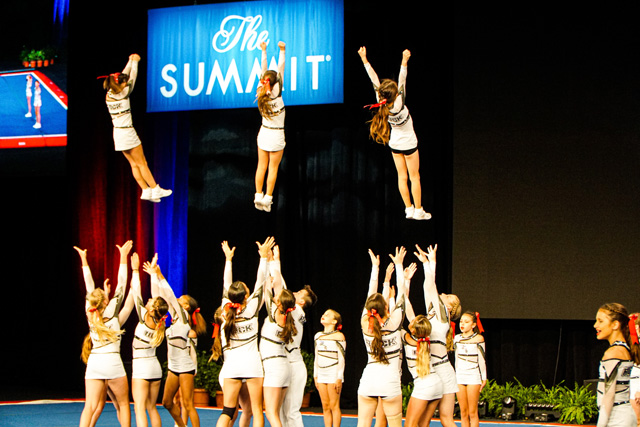Bottom of the Pyramid?

(Clayton Scelzi)
By Brittany Aubain
When you hear the word cheerleader, what’s the first idea that comes to mind? Usually, it’s the stereotypical portrayal of loud chants and pom-poms.
What about concussions and broken bones? Or, what about paying hundreds, maybe even thousands, of dollars in uniforms, accessories, and practice venues? Not to mention the hours upon hours spent in practices, performances, and workouts, all while maintaining a certain GPA.
These are just a few of the challenges collegiate cheerleaders face throughout their college careers. For years, cheerleaders have complained about the unfair treatment of their sport, while other teams are showered in perks and apparel. Some may say cheerleaders get the short end of the stick because many do not consider cheerleading to be an official sport. According to Dailyrepublic.com, “Cheerleading is not commonly considered a sport because of the inability to compete against an opponent. It is an activity solely dedicated to entertaining and motivating the crowd during sports events.”
For quite some time, cheerleading was seen as sideline entertainment. Despite its years of change and development, some athletic departments still do not see cheerleading as an official sport. Cheerleading teams have gone from cheering and waving on the sidelines to performing full-out athletic routines during pre-game, timeouts, and halftime.
Natalie Leon, a former Lehman College cheer coach, says, “Cheerleading has advanced so much since its original objective to where it is now. So many teams focus more on competing than just being sole entertainment.” As Leon mentioned, most teams have shifted their focus from small performances to high-stakes competition. Most high school and collegiate cheer teams compete under Universal Cheer Association (UCA), while all CUNY schools have their own CUNYAC Cheerleading championships.
Though many say cheerleading is not a sport due to the lack of a transparent point system, every competitive cheerleading team is judged with the same score sheet provided by UCA. According to this scoresheet, teams are judged on the following categories: crowd leading, skill incorporation, cheer overall impression, partner stunts, pyramids, building overall, standing/ running tumbling, basket tosses, and overall routine.
More importantly, cheer teams also have specific guidelines to follow in order to avoid deductions. A deduction is a certain number of points removed from the team’s score if a guideline was not followed. Some reasons for deductions include minor and significant tumbling falls (0.25-0.5 point deduction), pyramid fall (4 point deduction), unsportsmanlike behavior (1 point deduction), exceeding time limit (3-7 point deduction), safety violations (2-5 point deduction) and many more. Even performing small celebratory rituals will lead to a deduction.
It is evident that there is a clear point system, yet many use this as an excuse to disregard cheerleading as a sport. When one flexed foot or one bobble can take the team from first place to third place, it is clear there is a quantitative accounting taking place.
Cheerleading is not only rigorous, it is dangerous as well. According to the American Academy of Pediatrics, cheerleading caused 65% of the catastrophic injuries suffered by female athletes. More importantly, based on research from Geisinger.com, there are over 30,000 cheerleading-related injuries a year, with the most common injury being a concussion. Some schools see more cheer-related injuries than football and soccer. These are some of the more disastrous injuries; cheerleaders also suffer from sprains, ligament tears, joint problems, busted lips, and skin gashes.
Monmouth University cheerleader Gabby Rivera recalls her worst injury from doing a low to high liberty, in which the flyer is in the air, standing on one leg. Rivera fell from the top of the stunt, almost five feet down, and suffered from a concussion and pinched nerves in her neck. After the injury, Rivera was out for two weeks. Luckily, Rivera was seen by athletic trainers immediately, which softened the blow. However, not everyone is that fortunate.
A former Lehman College cheerleader, who wishes to remain anonymous, recalls being refused medical treatment. They tore their ACL during practice, and when they went to seek help from the athletic trainer, they received ice and were told to call 911. Their teammates had to play “athletic trainer” and make their teammate feel as comfortable as possible until help arrived. Yet fellow athletes on other teams are entitled to thousands of dollars in medical treatment, massages, and other luxury treatments free of charge.
Most say this is due to a lack of funds. Leon mentioned that she was told by Lehman’s former athletic director that there is not enough money in the budget for the cheerleading team. The Netflix docuseries Cheer mentioned that Navarro College only has one athletic trainer that oversees every athlete on every sports team. Even a larger school with a larger cheer budget suffers from a lack of medical staff.
One of the most pressing issues surrounding the safety of cheerleading is that there are no clear safety guidelines. To be the best, cheerleaders must perform hazardous stunts with little to no spotters. This means that if the athlete in the air falls, there are not many people around to catch them.
Despite the sport rigor and risk, some still diminish the hard work of these athletes. As collegiate sports resume, many cheer teams hope for change and better care.
Saved under Featured Slide, News
